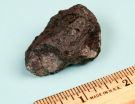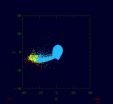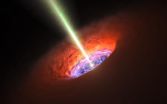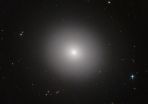(Press-News.org) Through a combination of data analysis and numerical modeling work, researchers have found a record of the ancient Moon-forming giant impact observable in stony meteorites. Their work will appear in the April 2015 issue of the Journal Science. The work was done by NASA Solar System Exploration Research Virtual Institute (SSERVI) researchers led by Principal Investigator Bill Bottke of the Institute for the Science of Exploration Targets (ISET) team at the Southwest Research Institute and included Tim Swindle, director of the University of Arizona's Lunar and Planetary Laboratory.
The inner Solar System's biggest known collision was the Moon-forming giant impact between a large protoplanet and the proto-Earth. The timing of this giant impact, however, is uncertain, with the ages of the most ancient lunar samples returned by the Apollo astronauts still being debated. Numerical simulations of the giant impact indicate this event not only created a disk of debris near Earth that formed the Moon, but it also ejected huge amounts of debris completely out of the Earth-Moon system. The fate of this material, comprising as much as several percent of an Earth mass, has not been closely examined until recently. However, it is likely some of it blasted main belt asteroids, with a record plausibly left behind in their near-surface rocks. Collisions on these asteroids in more recent times delivered these shocked remnants to Earth, which scientists have now used to date the age of the Moon.
The research indicates numerous kilometer-sized fragments from the giant impact struck main belt asteroids at much higher velocities than typical main belt collisions, heating the surface and leaving behind a permanent record of the impact event. Evidence that the giant impact produced a large number of kilometer-sized fragments can be inferred from laboratory and numerical impact experiments, the ancient lunar impact record itself, and the numbers and sizes of fragments produced by major main belt asteroid collisions.
Once the team concluded that pieces of the Moon-forming impact hit main belt asteroids and left a record of shock heating events in some meteorites, they set out to deduce both the timing and the relative magnitude of the bombardment. By modeling the evolution of giant impact debris over time and fitting the results to ancient impact heat signatures in stony meteorites, the team was able to infer the Moon formed about 4.47 billion years ago, in agreement with many previous estimates. The most ancient Solar System materials found in meteorites are about one hundred million years older than this age.
Insights into the last stages of planet formation in the inner solar system can be gleaned from these impact signatures. For example, the team is exploring how they can be used to place new constraints on how many asteroid-like bodies still existed in the inner Solar System in the aftermath of planet formation. They can also help researchers deduce the earliest bombardment history of ancient bodies like Vesta, one of the targets of NASA's Dawn mission and a main belt asteroid whose fragments were delivered to Earth in the form of meteorites. It is even possible that tiny remnants of the Moon-forming impactor or proto-Earth might still be found within meteorites that show signs of shock heating by giant impact debris. This would allow scientists to explore for the first time the unknown primordial nature of our homeworld.
Co-author Swindle, who specializes in finding the times when meteorites or lunar samples were involved in large collisions, said: "Bill Bottke had the idea of looking at the asteroid belt to see what effect a Moon-forming giant impact would have, and realized that you would expect a lot of collisions in the period shortly after that.
"Here at LPL, we had been determining ages of impact events that affected meteorites, and when we got together, we found that our data matched his predictions," he added. "It's a great example of taking advantage of groups that work in two different specialties - orbital dynamics and chronology - and combining their expertise."
Intriguingly, some debris may have also returned to hit the Earth and Moon after remaining in solar orbit over timescales ranging from tens of thousands of years to 400 million years.
"The importance of giant impact ejecta returning to strike the Moon could also play an intriguing role in the earliest phase of lunar bombardment," said Bottke, who is an alumnus of the University of Arizona's Lunar and Planetary Laboratory. "This research is helping to refine our time scales for 'what happened when' on other worlds in the Solar System."
Yvonne Pendleton, Director of the NASA SSERVI Institute, notes: "This is an excellent example of the power of multidisciplinary science. By linking studies of the Moon, of main belt asteroids, and of meteorites that fall to Earth, we gain a better understanding of the earliest history of our Solar System."
INFORMATION:
This research was supported in part by NASA's Solar System Exploration Research Virtual Institute (SSERVI) at NASA's Ames Research Center in Moffett Field, California. SSERVI is funded by the Science Mission Directorate and Human Exploration and Operations Mission Directorate at NASA Headquarters to enable cross-team and interdisciplinary research that pushes forward the boundaries of science and exploration.
For more information about SSERVI, visit:
http://sservi.nasa.gov
For more information about SwRI, visit:
http://www.boulder.swri.edu/
For more information about NASA's DAWN mission, visit:
http://dawn.jpl.nasa.gov/
A skin cell responsible for scarring, and a molecule that inhibits the cell's activity, have been identified by researchers at the Stanford University School of Medicine.
The molecule slowed wound healing in mice but alleviated scarring, the researchers said.
The researchers also found that the cell may play a role in the growth of melanoma and in skin damage caused by radiation. A drug that acts in the same way as the inhibitory molecule is already approved for use in humans as a treatment for type-2 diabetes, so it could potentially move quickly into clinical trials ...
For more than 250 million years, four-limbed land animals known as tetrapods have repeatedly conquered the Earth's oceans. These creatures--such as plesiosaurs, penguins and sea turtles--descended from separate groups of terrestrial vertebrates that convergently evolved to thrive in aquatic environments.
In a new scientific review, a team of Smithsonian scientists synthesized decades of scientific discoveries to illuminate the common and unique patterns driving the extraordinary transitions that whales, dolphins, seals and other species underwent as they moved from land ...
Supermassive black holes, often with masses billions of times that of the Sun, are located at the heart of almost all galaxies in the Universe. These black holes can accrete huge amounts of matter in the form of a surrounding disc. While most of this matter is fed into the black hole, some can escape moments before capture and be flung out into space at close to the speed of light as part of a jet of plasma. How this happens is not well understood, although it is thought that strong magnetic fields, acting very close to the event horizon, play a crucial part in this process, ...
A global study on canine rabies, published today (16 April 2015), has found that 160 people die every single day from the disease. The report is the first study to consider the impact in terms of deaths and the economic costs of rabies across all countries. Even though the disease is preventable, the study says that around 59,000 people die every year of rabies transmitted by dogs.
The multi-author study, by the Global Alliance for Rabies Control's Partners for Rabies Prevention Group, also shows that annual economic losses because of the disease are around 8.6 billion ...
Scientists have discovered a protein that plays a central role in promoting immunity to viruses and cancer, opening the door to new therapies.
Experiments in mice and human cells have shown that the protein promotes the proliferation of cytotoxic T cells, which kill cancer cells and cells infected with viruses. The discovery was unexpected because the new protein had no known function and doesn't resemble any other protein.
Researchers from Imperial College London who led the study are now developing a gene therapy designed to boost the infection-fighting cells, and ...
A major astrophysical mystery has centred on how massive, quiescent elliptical galaxies, common in the modern Universe, quenched their once furious rates of star formation. Such colossal galaxies, often also called spheroids because of their shape, typically pack in stars ten times as densely in the central regions as in our home galaxy, the Milky Way, and have about ten times its mass.
Astronomers refer to these big galaxies as red and dead as they exhibit an ample abundance of ancient red stars, but lack young blue stars and show no evidence of new star formation. The ...
San Antonio -- April 16, 2015 -- A NASA-funded research team led by Dr. Bill Bottke of Southwest Research Institute (SwRI) independently estimated the Moon's age as slightly less than 4.5 billion years by analyzing impact-heated shock signatures found in stony meteorites originating from the Main Asteroid Belt. Their work will appear in the April 2015 issue of the journal Science.
"This research is helping to refine our time scales for 'what happened when' on other worlds in the solar system," said Bottke, of the Institute for the Science of Exploration Targets (ISET). ...
April 16, 2015, NEW HAVEN, CT - With poor sanitation estimated to cause 280,000 deaths per year worldwide, improving sanitation is a key policy goal in many developing countries. Yet governments and major development institutions disagree over how to address the problem. A new study released in Science today found that in Bangladesh, a community-motivation model that has been used in over 60 countries to increase use of hygienic latrines had no effect, yet latrine coverage expands substantially when that model is combined with subsidies for hygienic latrines targeted to ...
Astronomers from Chalmers University of Technology have used the giant telescope Alma to reveal an extremely powerful magnetic field very close to a supermassive black hole in a distant galaxy. The results appear in the 17 April 2015 issue of the journal Science.
A team of five astronomers from Chalmers University of Technology have revealed an extremely powerful magnetic field, beyond anything previously detected in the core of a galaxy, very close to the event horizon of a supermassive black hole. This new observation helps astronomers to understand the structure and ...
Astronomers have shown for the first time how star formation in "dead" galaxies sputtered out billions of years ago. The NASA/ESA Hubble Space Telescope and ESO's Very Large Telescope (VLT) have revealed that three billion years after the Big Bang, these galaxies still made stars on their outskirts, but no longer in their interiors. The quenching of star formation seems to have started in the cores of the galaxies and then spread to the outer parts. The results will be published in the 17 April 2015 issue of the journal Science.
A major astrophysical mystery has centred ...








